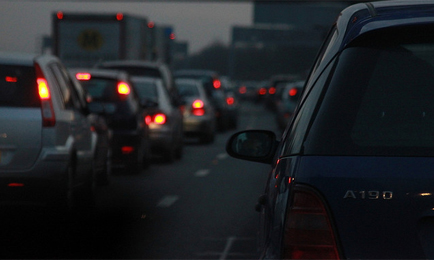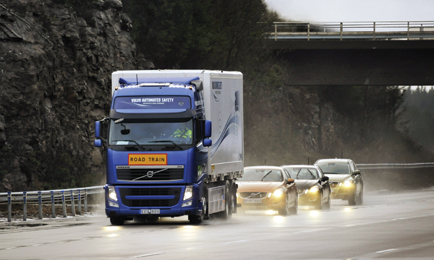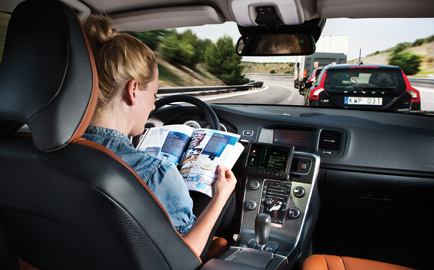Cone zone: Soaring road maintenance bills are adding to local authorities’ woes
The first decades of the 21st century could prove to be a time of seismic change for road transport in Britain. Our rail network underwent change on a similar scale in the decades after the Second World War. Are there lessons for the highways from the railways’ mistakes and successes?
Many of Britain’s roads are in poor condition. The chances of renovating them are receding as budgets are squeezed. A recent survey revealed an £829 million shortfall in English councils’ annual budgets for road maintenance. The rail network at the end of the war was similarly dilapidated, but its fate was also shaped by rapid technological developments. Improvements in design and production made car ownership affordable to many people. Meanwhile British Railways was refining steam locomotives. It stopped building machines with this pre-Victorian technology a year after the first Minis went on sale.
Steam locos were inefficient not only as individual vehicles but also in their infrastructure of depots, coaling points and water supply. To spot equivalent inefficiency on today’s roads, we need only glance at rush-hour traffic jams or commuter car parks. More than six in 10 cars and vans on UK roads have only one occupant. And cars are in use for just 4% of the time.

Rush hour: Vehicle numbers go on rising while their occupancy rates fall
The improved efficiency of individual cars over the past few decades is dwarfed by the profligacy that single-occupancy represents collectively – in land use, congestion and energy consumption. Rolling stock engineer Ian Walmsley argues that car owners put other considerations ahead of efficiency. “Cars don’t follow economic rules,” he says. “They are primarily an emotional purchase and can’t be compared to rail. If you consider the asset utilisation of cars, it is hopeless – but it doesn’t matter as they are not bought for that.”
Current trends in technology appear to favour rail over roads. The internet has leapt from home computers to portable devices which you can use to keep in touch with mates, play games or watch films while travelling – as long as you’re not driving. It’s been suggested that devices like the iPhone or iPad have replaced cars in young consumers’ aspirations, while social networking and online gaming have partly edged out face-to-face socialising and the associated journeys.
The internet’s dominance in our lives may partly explain why passenger kilometres on Network Rail’s routes increased by 44% in the past 10 years. Simultaneously, distance travelled on roads decreased for all vehicle types except light goods vehicles – which deliver your internet purchases to your door and save another journey to the shops when you discover the new garment doesn’t fit you.
Some suggest that Britain has reached or passed “peak car”, arguing that traffic won’t resume its previous or forecast rate of growth as the economy recovers. A more nuanced interpretation of trends is that the way we use roads is changing as a result of various factors including the internet, parking shortages, global demand for oil, the continuing urbanisation of the population and repeated warnings about the health effects of lack of routine exercise.
BR was slow to heed changes in the use of railways in the 1950s. It invested in marshalling yards and outdated wagons for small freight consignments which road hauliers were already taking from its hands.
Stephen Joseph, chief executive of the Campaign for Better Transport, believes Britain is in danger of repeating that mistake by implementing road projects that were designed decades ago. He says the current plan to dual the A556, between the M6 and M56 in Cheshire, was rejected in the 1990s and since then traffic in the area hasn’t grown as predicted. “Had they built it then, they would have built a big road with not much traffic on it, because their forecast was an absurd over-estimate,” he says.
However, Alexander Jan, a director at consultancy Arup, believes that traffic growth will resume as the economy picks up. His concern is that financial constraints may lead us into repeating another of BR’s mistakes – closing or narrowing routes.
Northamptonshire County Council is proposing to close duplicate “bridges, roads or footways” and reduce the width of some rural roads to single carriageway, which it says would give priority to non-motorised users and “allow flexibility in maintenance standards”, for example where road edges are breaking up.
Jan says: “Local government has had to bear the brunt of grant reductions from central government. The risk is that it’s penny wise and pound foolish in the long term. If you’ve got a structure that needs to be kept in good condition and you let it go into disrepair, the risk is that you face an enormous bill if and when you try to bring the asset back into service. One of the tragedies of Beeching was that alignments were lost which today could be brought back into use.”
Walmsley concurs. “The message I would take from the BR experience is not to fall for the same myth that an asset in place is costing you money. Do we really think singling the Kemble lines saved money, for example?” Network Rail is now spending £45 million to restore the 19km of second track between Swindon and Kemble. “Why didn’t we just leave them there and not use them?” says Walmsley. “It is an accounting rule that says these assets cost money but they don’t. The idea of spending money to narrow roads is absurd, especially when Britain’s population is growing.”
Could there be scope for narrowing roads that were widened before being bypassed by motorways or dual carriageways? Jan says: “I can see why highways authorities are tempted to pull back from maintenance, particularly if there’s an alternative route.”
BR’s assumption that single track is more cost-effective than double resulted in fatal accidents which would not have happened had traffic in opposing directions remained segregated. Jan warns that reducing dual carriageways to single, with no central crash barrier, would increase the risk of accidents.
Maintaining railways according to their traffic enabled savings on routes where heavy locos gave way to lightweight diesel or electric units. Should highways engineers emulate that, rather than aspire to provide a network that’s universally available to all vehicles? Constraints such as low bridges and narrow country lanes already divide the network into different categories of capability in an ad hoc way. Northamptonshire’s plan to narrow some rural routes has the hallmarks of a strategy to connect a road’s maintenance standards to the nature of its users.
Jan says he can understand a local authority deciding not to strengthen a bridge for a higher axle load, where an alternative route exists, but adds: “You’re then up against risk-based maintenance. Do you maintain assets to a standard or a risk level? Engineers have different views on these things. Everyone gets nervous when you move to a risk-based approach, even if it makes good financial sense.”
While repeated reductions in BR’s budget had many negative consequences, they also encouraged innovative responses from engineers such as the Total Operations Processing System. Imported from the US in the 1970s, this used a centralised computer system to keep tabs on each item of rolling stock. BR also spotted the potential of computing power to handle the repetitive operation of signalling. Solid-state interlocking first went live in 1985 and became a successful British export.
Other signalling innovations enabled BR to cut the cost of operating and maintaining lightly used railways, deflecting suggestions that such lines should be closed. Under radio signalling, first deployed in 1984 on the Kyle of Lochalsh line, train drivers received authorisation to enter each section of single track via the airwaves, rather than from the hands of signalmen.
Shrinking council budgets are begetting innovation on the highways network, where LED street lighting is becoming common. Some councils have opted for part-night lighting. Dorset, for example, recently adapted thousands of lamps in residential streets to illuminate from dusk till midnight, and from 5.30am to dawn in winter.
The removal of illuminated trackside signals on rural railways could be echoed by simplification of the road network’s signalling. The experimental extinguishing of traffic lights at a busy junction in Portishead, near Bristol, in 2009 improved traffic flow and the local authority’s maintenance burden. At other junctions, complex designs to regiment each user’s passage have been replaced with shared space, where users pick their way across with plenty of eye contact.
Jan comments: “London is arguably over-traffic-lighted, if there’s such a phrase. I think there’s a case for authorities to review traffic lights, not only because of the cost of maintaining them but because as development patterns change and driver behaviour is better understood it would be a win-win. A zebra crossing is low-tech and smart.”
BR’s early adoption of computer technology could be mirrored on our roads if today’s IT revolution, centred on mobile internet connectivity, can be married to cars and lorries. Manufacturers are testing self-driving cars, which they hope will give drivers the freedom to use tablets or phones while travelling on motorways or inching through traffic jams. Google, which has already transformed the internet, has been adapting production vehicles for several years to trial its “autonomous car” technology.
Tests in Japan of heavy goods vehicles running as a platoon, where lorries automatically follow the human-driven leading vehicle, are reported to have shown fuel economies of 15% or more, as a result of reduced aerodynamic drag. The lorries operate like a train, and individual units can leave or join the convoy as required.

Safer solution: Vehicle platoons are one answer to driver fatigue
However, concepts that are simple in theory must demonstrate belt-and-braces reliability before entering the real world, where a technical hiccup could cause fatalities. The mobile internet is having a more immediate impact in the form of tools to reduce cars’ inefficiency.
Westminster City Council, for example, is fitting parking bays with sensors to guide drivers, via a smartphone app, to unoccupied spaces, potentially reducing mileage by circling motorists. The internet is breathing new life into the long-established concepts of car clubs and car sharing.
“What we’re going to see in the next 20 years is application of technology to cars which will create enormous disruptive effect on traffic, over the medium term,” predicts Jan. “For example, the car-sharing model is going to expand. It’s not impossible that a car that’s driven by a computer will be on the roads, and so the driver will be able to do things productively. That may increase how much time people will be prepared to spend in traffic. As cars become more internet-enabled and user friendly, it could have a very interesting effect.”

Reading room: People may be willing to spend more time in traffic if the car takes over the driving